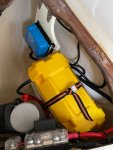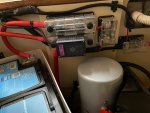wipe_out
Well-Known Member
Hi all,
We are in the process of fitting a Side Power SE50 12V bow thruster and I am trying to decide on the wiring plan which I am going to do myself.. I have no issue doing the wiring but I have come up with 3 options and wanted some input from the group as perhaps a logic/sanity check..
Our domestic and starter banks (linked by VSR) are in the middle of the boat under the seats so in terms or wiring only probably 3.5-4m away from the thruster (I will accurately measure this weekend).. According to the manual at less than 7m (round trip circuit length) a 50mm2 cable is recommended and at 7-14m a 70mm2 to 95mm2 cable is suggested.. The windlass already has what I think is either a 50mm2 or 70mm2 cable in place running back to the batteries.. The windlass cable has no markings so I can't be sure of the size exactly..
Here are the plans I have come up with so far..
Option 1 (Easiest)
Replace the windlass cable with a known 70mm2 cable running back to the batteries and run both the thruster and windlass on this cable.. Obviously with appropriate fusing etc. in the correct places.. Up side is this would be the easiest option and would have the added support of the alternator and all batteries combined for the thruster load.. Down side would be some voltage drop at the thruster of about 0.8-0.9v but since the engine would be running this should still see about 12.5-13v being delivered to the thruster..
Option 2 (Probably cheapest)
Add an additional 35mm2 cable to run along side the existing windlass cable to reach the required square area of copper but not sure on the correct fusing for this arrangement.. For example do I fuse each cable individually for it's rating or join the two cables together and fuse together as it it was a single cable? This would have similar pro's and cons to Option 1..
Option 3 (Most complicated and expensive)
Get a shelf or similar glassed into the bow area next to the thruster to support an additional battery to run the bow thruster.. Install a Victron DC-DC 18A charger in the bow to charge the battery from the other battery banks with a 10mm2 cable running back to the batteries.. Pro for this would be minimal voltage drop but the down side this is a much bigger job to get the shelf made that is strong enough and would cost more with the additional battery and DC-DC charger etc..
Anyway that's the basic thought process.. What are the opinions out there?
Thanks..
We are in the process of fitting a Side Power SE50 12V bow thruster and I am trying to decide on the wiring plan which I am going to do myself.. I have no issue doing the wiring but I have come up with 3 options and wanted some input from the group as perhaps a logic/sanity check..
Our domestic and starter banks (linked by VSR) are in the middle of the boat under the seats so in terms or wiring only probably 3.5-4m away from the thruster (I will accurately measure this weekend).. According to the manual at less than 7m (round trip circuit length) a 50mm2 cable is recommended and at 7-14m a 70mm2 to 95mm2 cable is suggested.. The windlass already has what I think is either a 50mm2 or 70mm2 cable in place running back to the batteries.. The windlass cable has no markings so I can't be sure of the size exactly..
Here are the plans I have come up with so far..
Option 1 (Easiest)
Replace the windlass cable with a known 70mm2 cable running back to the batteries and run both the thruster and windlass on this cable.. Obviously with appropriate fusing etc. in the correct places.. Up side is this would be the easiest option and would have the added support of the alternator and all batteries combined for the thruster load.. Down side would be some voltage drop at the thruster of about 0.8-0.9v but since the engine would be running this should still see about 12.5-13v being delivered to the thruster..
Option 2 (Probably cheapest)
Add an additional 35mm2 cable to run along side the existing windlass cable to reach the required square area of copper but not sure on the correct fusing for this arrangement.. For example do I fuse each cable individually for it's rating or join the two cables together and fuse together as it it was a single cable? This would have similar pro's and cons to Option 1..
Option 3 (Most complicated and expensive)
Get a shelf or similar glassed into the bow area next to the thruster to support an additional battery to run the bow thruster.. Install a Victron DC-DC 18A charger in the bow to charge the battery from the other battery banks with a 10mm2 cable running back to the batteries.. Pro for this would be minimal voltage drop but the down side this is a much bigger job to get the shelf made that is strong enough and would cost more with the additional battery and DC-DC charger etc..
Anyway that's the basic thought process.. What are the opinions out there?
Thanks..


